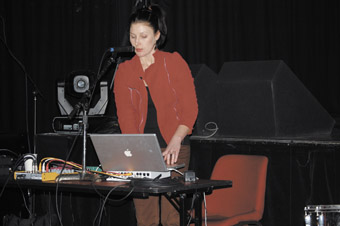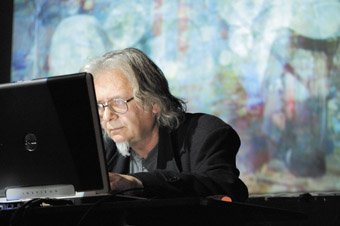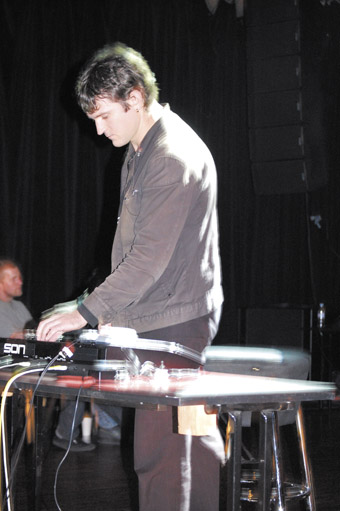sounds solid, sounds fluid
gail priest: liquid architecture 9, Sydney

Kusum Normoyle, Liquid Architecture 9 Sydney
photo Alison Richardson
Kusum Normoyle, Liquid Architecture 9 Sydney
THE ROMANTIC IN ME WILL ALWAYS FEEL THAT THE IDEAL VENUE FOR EXPLORATORY MUSIC AND SOUND IS THE SMALL DINGEY SPACE WITH THE MAKESHIFT SEATING, THE MILKCRATE TABLES AND THE QUIET TENSION OF A SMALL ATTENTIVE AUDIENCE. HOWEVER THE FESTIVALS THAT GALVANISE THE OFTEN SCATTERED COMMUNITIES OF EXPERIMENTAL MUSIC MAKERS NEED LARGER VENUES THAT CAN ACCOMMDATE BIGGER AUDIENCES, BETTER SOUND SYSTEMS AND OVERGROUND MARKETING CAMPAIGNS.
For the last three years the Sydney leg of Liquid Architecture has partnered with Performance Space, utilising the Cleveland Street premises and the new CarriageWorks complex. While this has provided great exposure to a wider audience, these venues have pushed the presentation mode closer to that of formal concert and for me this often brings with it a sense of claustrophobia.
This year, with new Sydney directors Alex White and Jennifer Teo in charge, the festival moved to The Factory in Marrickville, home to eclectic programming generally on the rock/popular music side but which has hosted the NOW Now festival in the past. This venue allowed for a more relaxed presentation however the serious rigour remained intact.
The festival opened with Kusum Normoyle, a relatively new addition to the Sydney sound landscape. She starts singing quiet, shakey notes that hang naked and vulnerable until one is looped, the tentative vibrato turning into texture. The analogue input of strident sibilants, hissing purrs and throaty growls is gradually folded in with feedbacks and statics to create a complex morass of sound. At one point it coalesces into slippery beats, at another into a distorted vocal cacophony with a gothic feel. Ideas and processes are mostly well structured into clear movements rather than the seemingly endless crescendo so common in improvised laptoppery, though the last section did seem to extend just a little beyond its natural life. That aside Normoyle’s approach to the partnership of vocals and computer processing is bold and intriguing.
Also focusing on voice, Canadian artist Robert Normandeau (in town courtesy of the Australasian Computer Music Conference), presented a stunning set in acousmatic style—precomposed work spatialised live. With alarming clarity he spins moans, cries, laughs and gasps around the multiple speakers, the combinations forming rhythmically punchy pieces. Cascading sheaths of sound seem almost gelatinous, yet within this, each element is precisely placed. The figurative nature of the samples is often preserved—he describes his work as “cinema for the ear”—giving some of the pieces a cartoon slapstick feel while others conjure B-grade sci-fi fantasies. The content may not have been to everyone’s taste, but the masterful execution was undeniable.

Jacques Soddel, Liquid Architecture 9 Sydney
photo Alison Richardson
Jacques Soddel, Liquid Architecture 9 Sydney
Not all the visuals had to be imagined. Jacques Soddell opened with video impressions of a face, shifting in and out of perception accompanied by liquid static. Big, rich sustained tones drive us through beautifully framed tunnels and telegraph lines, followed by an aggressive overload of interference laden, cutup media images and the sound equivalent of dirty pointillism. Besides the ‘meaningful’ conclusion (the image of a church altar), Soddell on the whole walks a fine line between abstraction and narrative which complements his sound explorations.
Toby Grime also used visuals. His sound is like a organism made of grainy drone that incrementally grows—understated yet somehow hinting at the ecstatic with luxurious shifting harmonies. He accompanies this with premade video material which maintains a similar tension. The close-up of a man’s mouth in profile, with water droplets suspended in air, looks like slick advertising. As the footage slowly moves in reverse, we discover that the captured moment is of the man literally spitting a dummy. While the simple narrative becomes clear, the sensuality of the footage combines with the suspension of the sounds to push us beyond literal interpretation.

Nat Bates, Liquid Architecture 9 Sydney
photo Alison Richardson
Nat Bates, Liquid Architecture 9 Sydney
There were two outstanding performances across the festival. One came from national festival director Nat Bates. Lit from behind, seated at a keyboard, Bates starts with a dramatic stadium rock sting. Using an antique Ensonique ASR10 sampler, he takes the iconic sounds of epic rock—cymbals, drums, grand full band stabs—and explores them as artefacts. By using the sounds minimally and deftly spatialising them, he lets us hear beyond the cliché to the timbral and textural essence of the sounds themselves. A cymbal plays out longer than is physically possible, cycling around the speakers: we identify it as a cymbal yet hear beyond it to the metal, to the computer bits that stretch it, to the room it was recorded in and the one in which it is played. It’s ear and mind expanding—an exploration of both the sound of a sound, and an interrogation of the meanings and associations imposed on it. The combined result of this sustain and suspense is intriguingly cinematic, even noirish. As a dramatic conclusion Bates triggers a final rock stab and a seemingly infinite reverb rings out…it’s still going as he leaves the stage.
The fitting climax to the festival came from Marcus Schmickler. Generally I don’t take up the option of earplugs. You end up missing vital frequencies, and perhaps it might be better just to turn it down. But with Schmickler the volume is the essence so I succumbed. Bass driven, his sound becomes physical—walls, floor, ceilings, internal organs begin to vibrate with his fierce, overlapping, ascending tones carving out another dimension. We are all at the centre of the Earth in the hot larval flow of Schmickler’s creation. With the strange internalisation that earplugs give I begin to feel that the music is emanating from within me, from us as an audience. The effect is powerful, verging on spiritual, with no drugs required.
Over two nights Sydney’s LA9 was smaller in scale than previous festivals, but limiting the acts to five per night was just right for maintaining audience attention. Nor did the program lack variety with approaches ranging from the brash noise hackings of Nick Wishart (Toydeath) and Hirofumi Uchino, to the quiet improvising organism of Metalog, to the sweet beats of Andrew Peckler, with some compact sound installations and a screening loop thrown in as well. Liquid Architecture on a national level has developed such a strong yet flexible curatorial approach over the nine years of its operation that the identity of the festival remains clear while allowing room for new directors to make their mark.
Liquid Architecture 9, Sydney; directors Alex White, Jennifer Teo, national director Nat Bates; Factory Theatre, July 11-12
RealTime issue #87 Oct-Nov 2008 pg. 48






